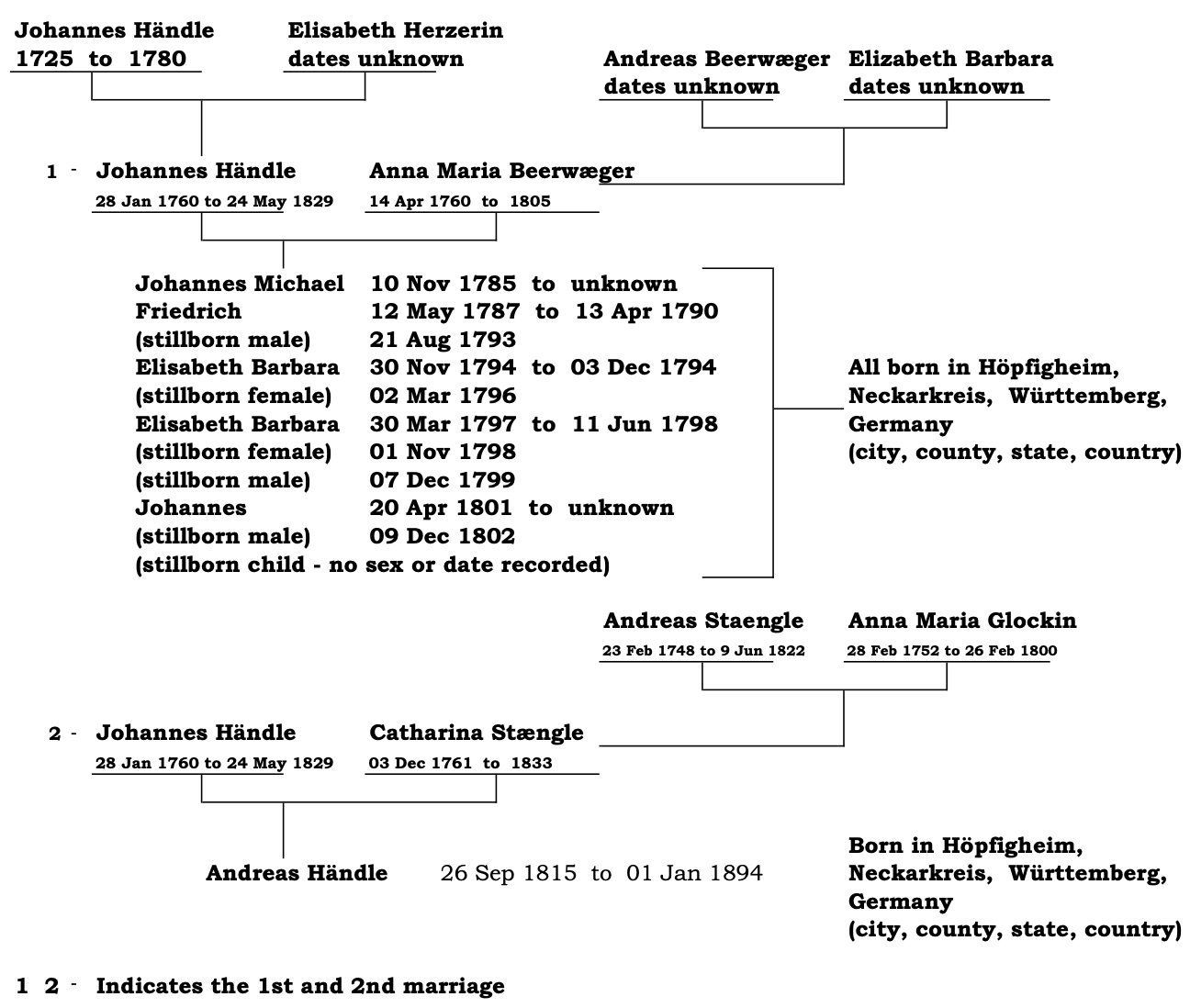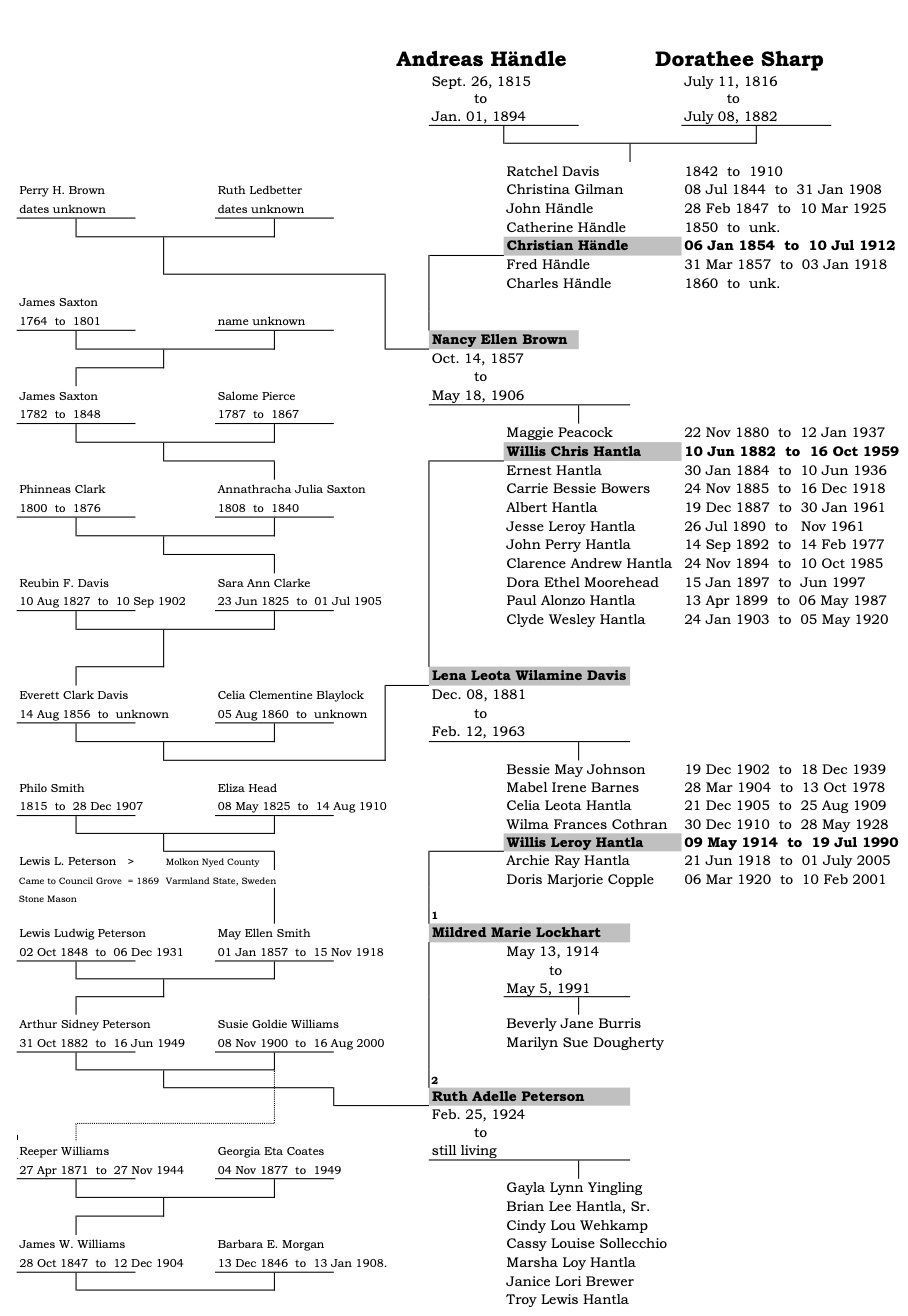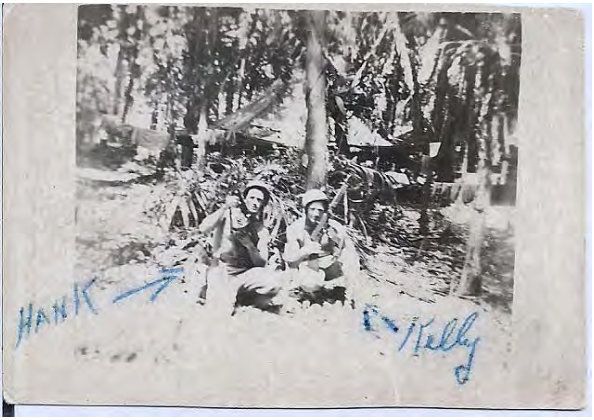Hantla Family
Händle
Genealogy
Written and researched by Brian Lee Hantla, Sr.
1982
Revised 1984, 1995, 2004, 2008
In 1982 my son Theron asked for help in putting together a family tree for a school project. I had heard several stories how the Hantla’s came from Germany. I was also told there was speculation that because the last name ended in “la” we were Finnish. So, I started out on my own with the help of my Aunt Doris Copple. She gave me the beginnings of a family tree surrounding Meade, Kansas and their movement from St. Johns, Kansas to Meade. She was a lot of help and directed me to family members and relatives. She gave me some of her old pictures of every Hantla she knew. Beyond that I had to strike out on my own.
At the time I had a job where travel was required and I found the research library of the Mormon Church in Salt Lake City through a friend in Idaho. I spent months there and found a whole new hobby. After finishing the initial research I spent the next two years finishing it. I found long lost relatives in Kansas, Illinois and New York. Together we pieced together the Hantla history.
Oddly enough over the next 27 years small pieces of missing history fell into place and more and more relatives sent me their renditions of Hantla history.
- Brian L. Hantla, Sr.
Andreas Händle – We begin October 5, 1856
His name was Andreas (Andrew) Händle, my Great Great Grandfather. Along with his wife Dorathee, their five children Ratchel, Christina, Johannes, Catherine and Christian, they left their home in HöpfigheimNeckarkreis-Baden Württemburg State-South Central Germany, and traveled to the Port of Bremen-Bremen-Hannover-State-North Germany. From Höpfigheim to Bremen, Germany is 383 miles. Bremen is on the Weser River, which is navigable. Walking or with a horse and buggy, they could have made 3-4 miles an hour. At that rate, their journey would have taken 4-6 days. No accounts have been found on how they traveled to Bremen.
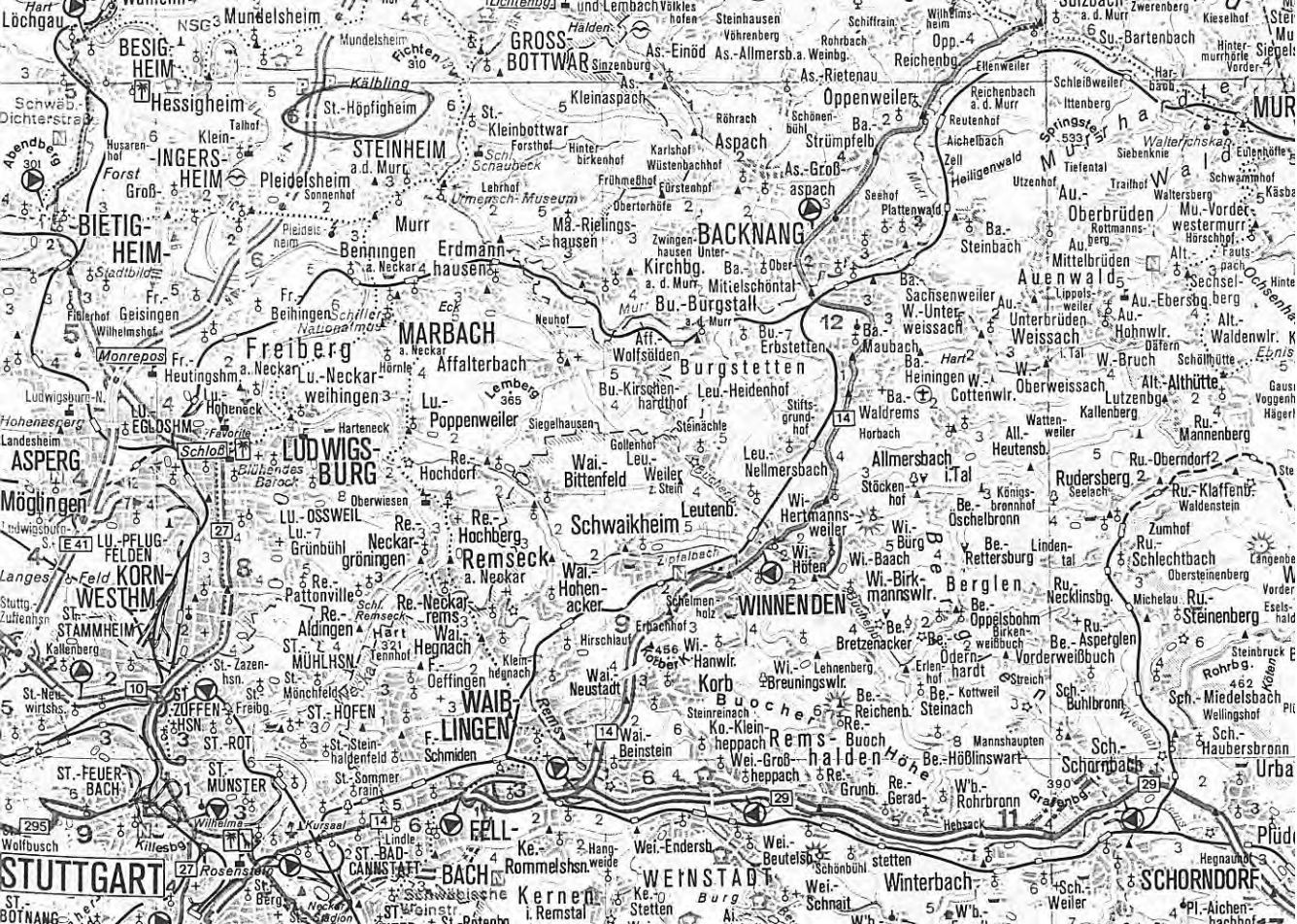
On October 5, 1856 they boarded the Bark New Orleans sail ship bound for the Port of Orleans in the U.S.A. Commanded by Master D. Kohlmann they set out on a 72-day trip to the U.S. They had 2 boxes under the 'baggage' column of the ships register. One was actually a green colored chest that was once in the possession Grace Griffith of New York. Grace was the Great granddaughter of Christina Händle Gilman. Her (Grace’s) daughter Anne Smith has looked for the chest but was unable to locate it. In that chest were the original tintypes of Andrew and Dora that you see later in this story. Anne Smith is in possession of the tintypes. Brian Hantla has a negative of the tintypes that was sent to him by Grace. Anne believes the chest was given away because no one knew the history behind it after Grace died. Can you believe that all the worldly possessions of 7 people were in two chests?
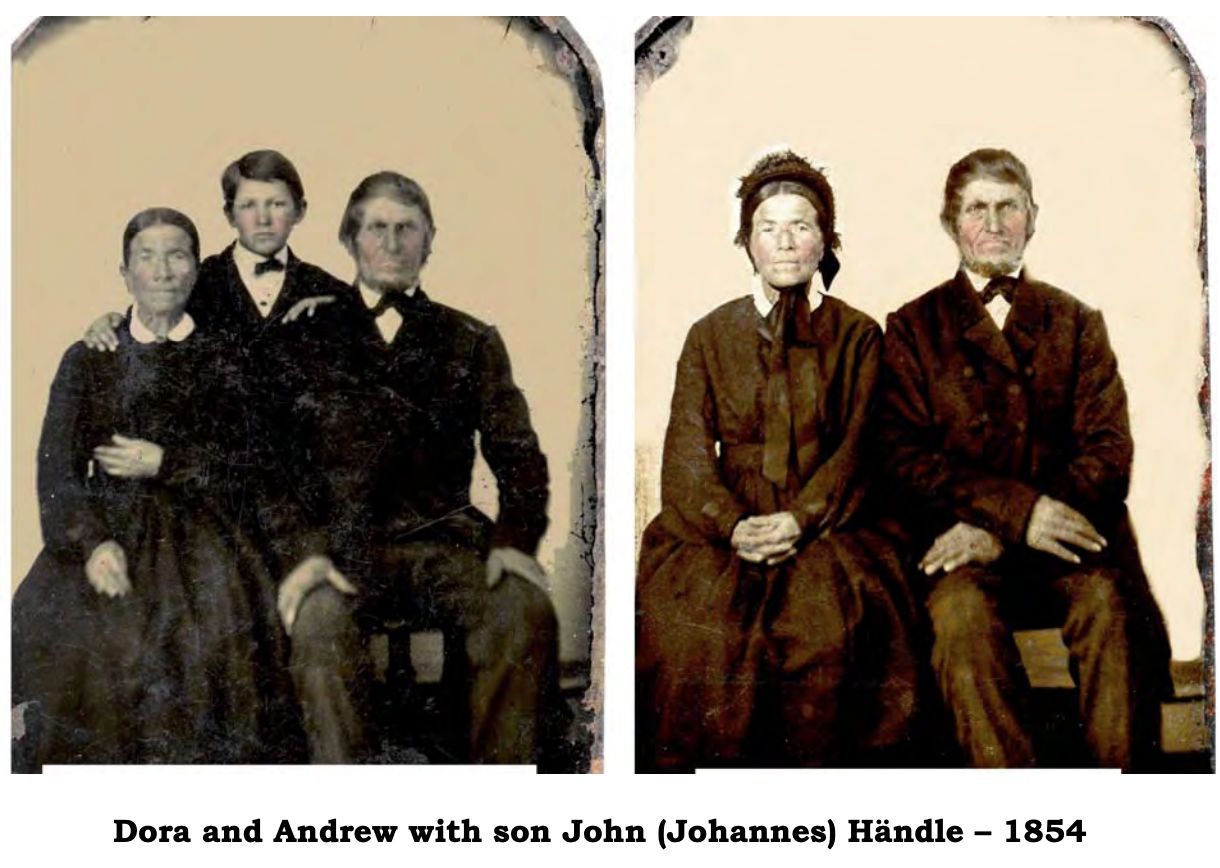
On the next two pages is the boat passage and manifest for the trip from Germany to the Port of Orleans. The ship had three hundred and fifteen passengers. Twenty-four died including 11 infants in the crossing from exposure, pneumonia and disease. No ship damage was reported, but two major storms delayed the arrival for nearly two weeks. Other stories state that even the passengers had to spend hours each day bailing water from the boat. If the wind was in back of them, they made progress, but if not, they drifted back.
The Bark New Orleans arrived in the Port of Orleans on December 16, 1856.
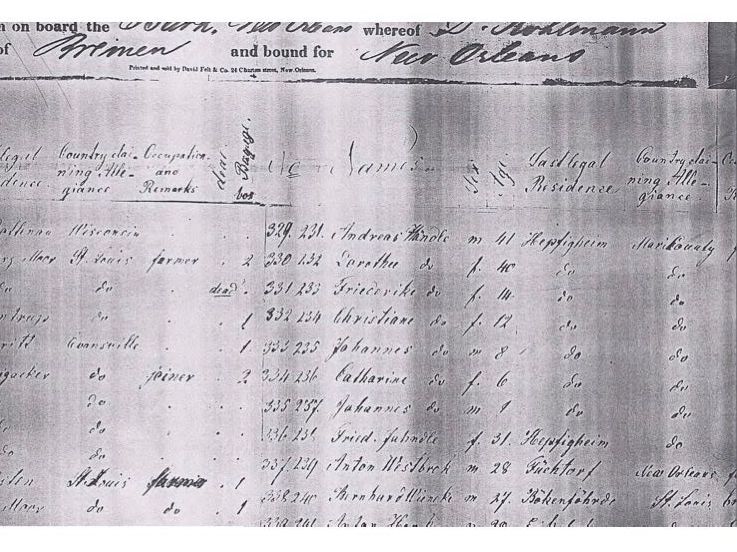
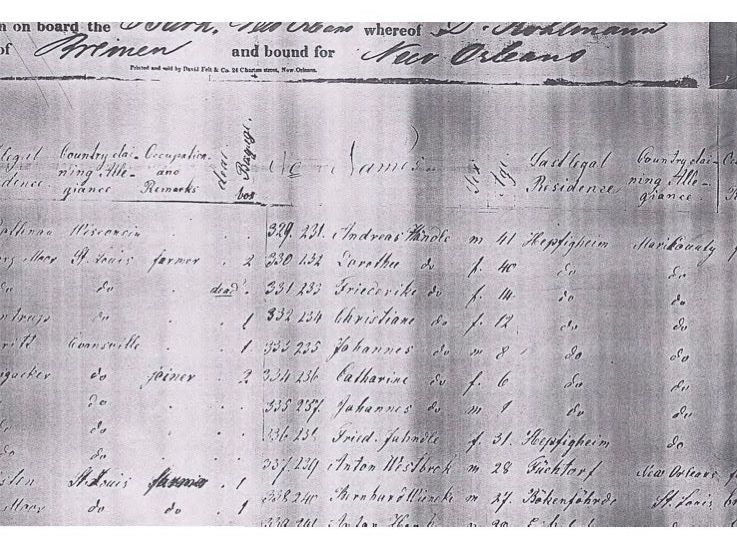
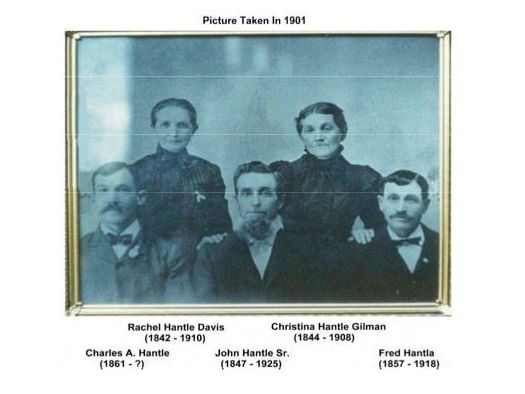
The sons and daughters of Andrew and Dora Händle. Notice the last name. John and Charles took the spelling of Hantle, and Christian (not pictured) and Fred chose the spelling of Hantla. More on the name change later.
Upon arrival in New Orleans the Händle family accompanied by Andrew’s brother Frederick, took a steamship up the Mississippi River to Alton, Illinois. No accounts or records on how long the trip took from New Orleans to Alton have been found, but one story has it that it took 5-6 days. From there they located in New Berlin, Illinois until 1870, and then relocated to Virden, Illinois and eventually to Raymond, Illinois. Two more children were born in Illinois, Fred and Charles. Andrew worked as a farm laborer.
Census takers over the years have Andrew’s last name as Hindle in 1860, Henley in 1870 and Hanttas in 1880. It’s no wonder we have had a hard time tracing him. The last name goes through a couple of changes before the turn of the century.
The census taken in 1860 has Andrew with assets of $500 in real estate and $50 in cash. They have him listed as farm laborer and gardener. For that time the family lived a good life and prospered in Illinois until Dora’s death in 1882 and Andrew’s death in 1894.
Dora died July 8, 1882. Dora is buried in Asbury Cemetery; Route 127; 2 mi. south of Raymond, Illinois; old cemetery, SW corner; round shaped 3 foot marker. But, Maynard Graham, president of the Asbury Cemetery in 2005, has no record of Dora being buried in the Asbury Cemetery. The local libraries do not have Dora listed as being buried in Asbury Cemetery. Anne Smith looked for the gravesite October 2005 but found no sign of it. Perhaps the stone has been destroyed. An alternate location is believed to be Raymond Cemetery. Dora is not buried with Andrew.
Andrew died January 1, 1894 at the age of 78. Death card states: 78 years, 3 months, and 6 days. Andrew was buried on the Charles Gilman/Gillman lot in the Old Dunkard Cemetery (German Baptist), now called Macoupin Creek Cemetery (2nd street east, off Main St., Farmersville, Illinois). A picture of his headstone is shown below. It is a square headstone and has names on all 4 sides. 8 names all together.
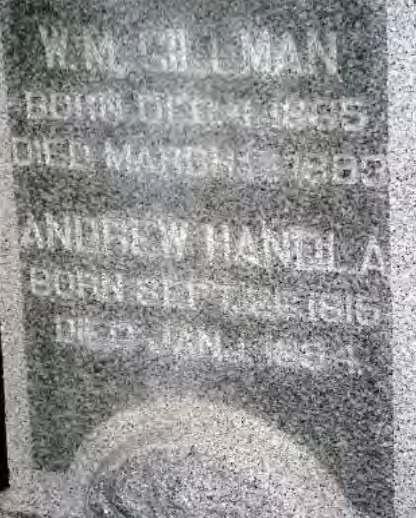
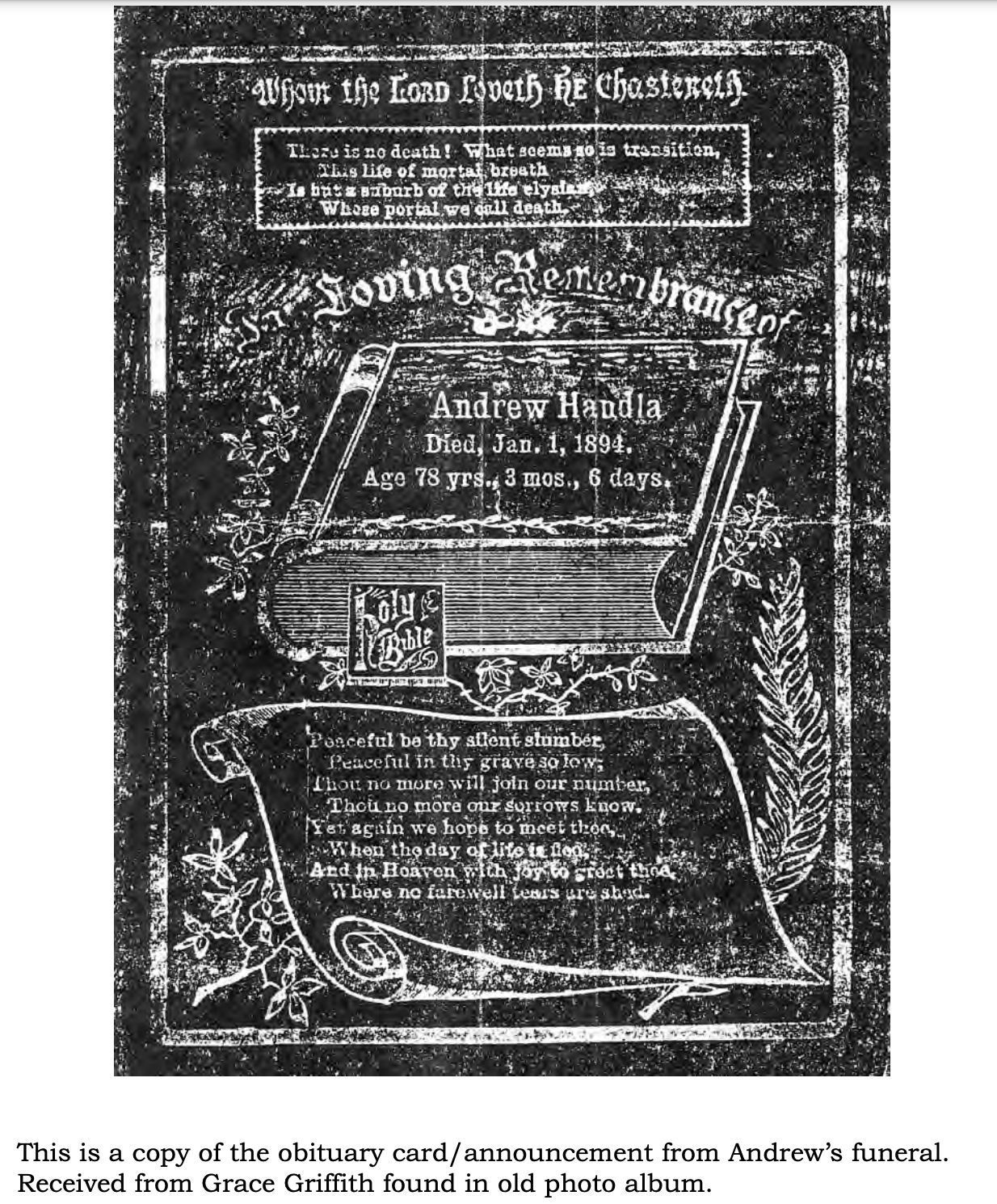
My Great Grandfather was Christian (Christ or Chris) Händle; son of Andrew and Dora. He was born January 6, 1854 and was two years old when he came to America. Christian had no formal education and worked alongside his father from the young age of 10 and spent his entire life as a farmer and farm laborer. In 1880 Christ married Nancy Ellen Brown from Lauderdale County, Tennessee.
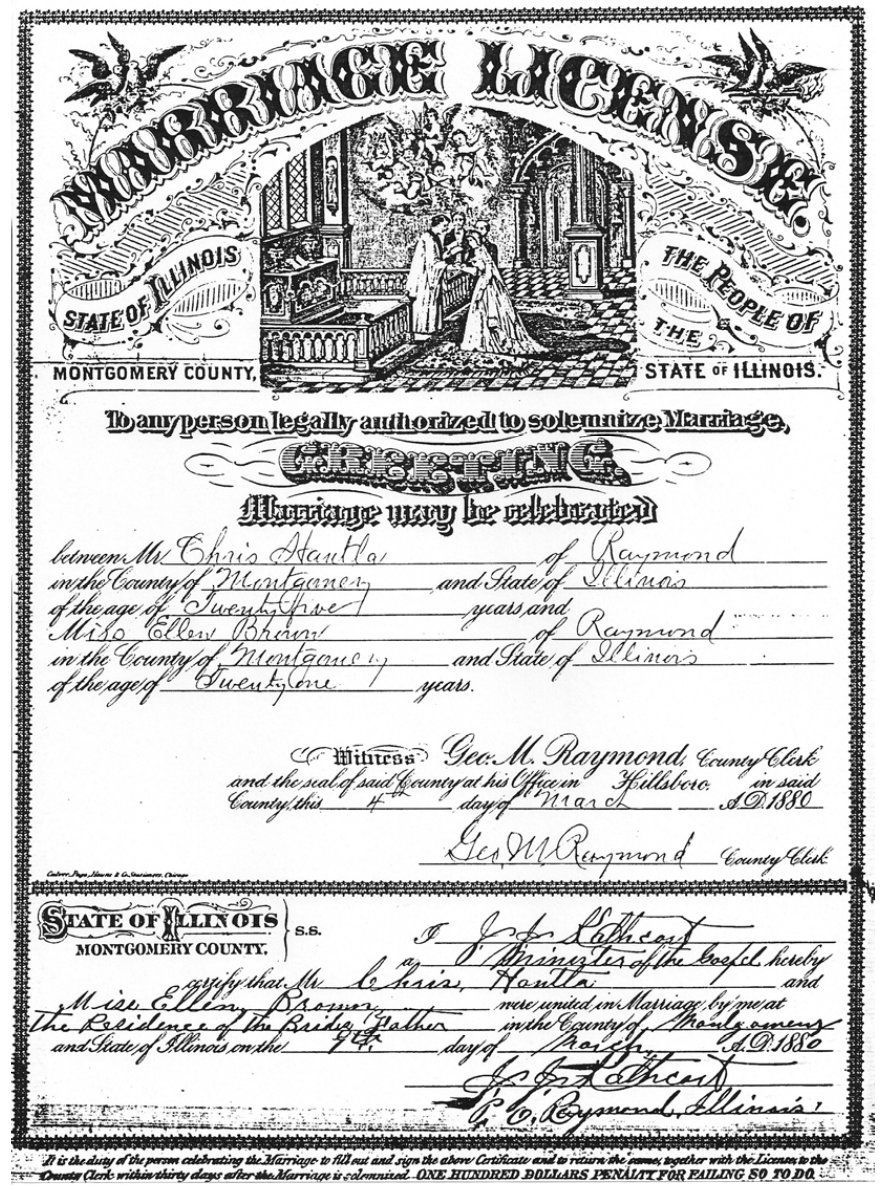
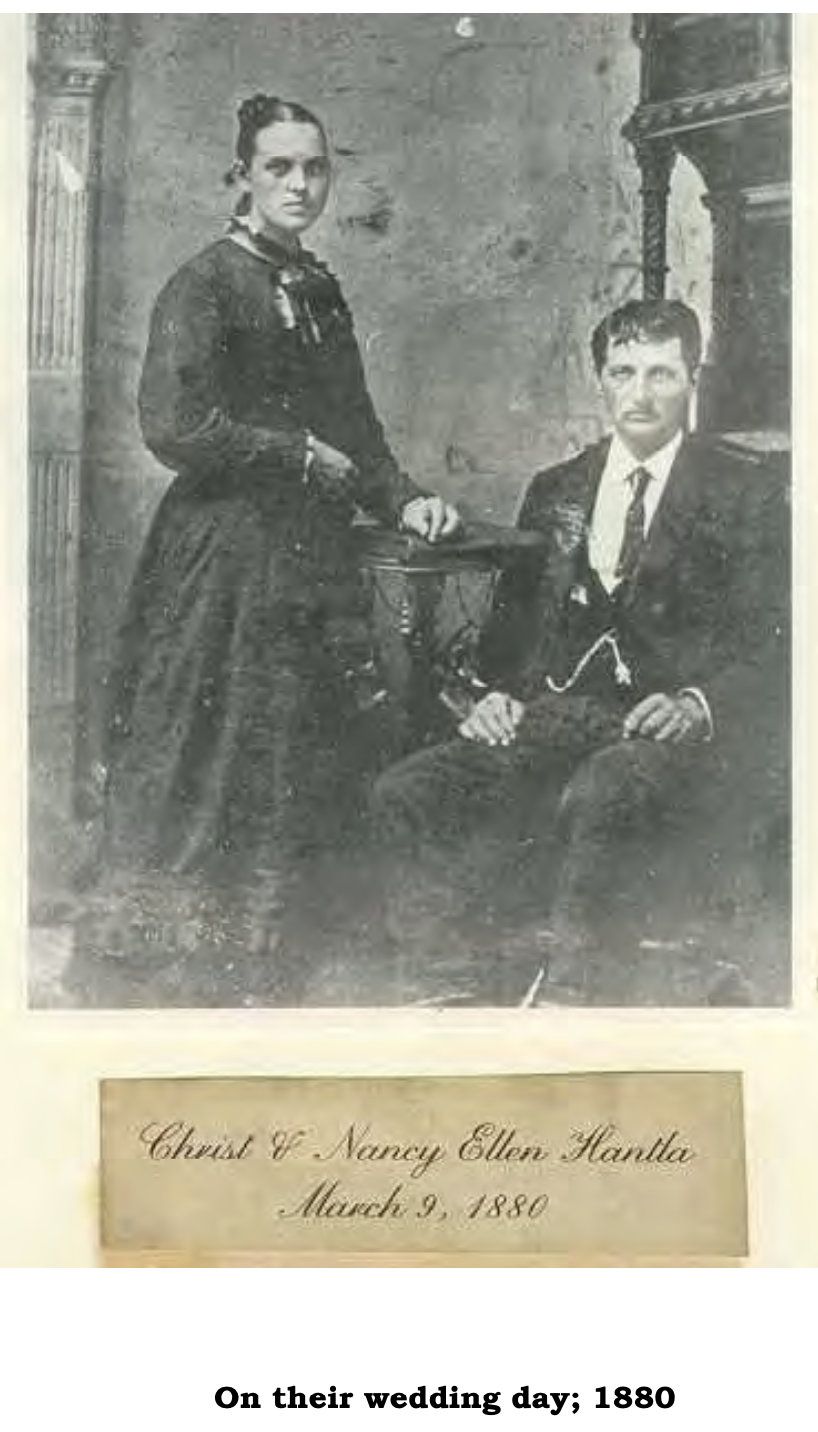
Nancy’s parents Perry and Ruth Ledbetter-Brown had sympathized with the North during the Civil War and fought against slavery. Their beliefs and economic pressure caused the Brown’s to move to Illinois where Nancy met Christian. Nancy was trained and educated for teaching and taught Christ to speak English.
As time passed living in a German neighborhood began to have many religious and moral drawbacks. Christ and Nancy had converted to a Free Methodist along with the Browns and had forced them to break from the German community because of their beliefs in the absence of liquor of any kind. They decide to migrate to the Prohibition State of Kansas. Christ and Nancy were advocates of Prohibition and both voted the straight Prohibition ticket as long as they lived.
In the summer of 1886 Christ, Nancy and their 4 children along with the Brown’s settled in Stafford County on a farm near Macksville, Kansas. They lived in sod house and seven more children were born in Kansas.
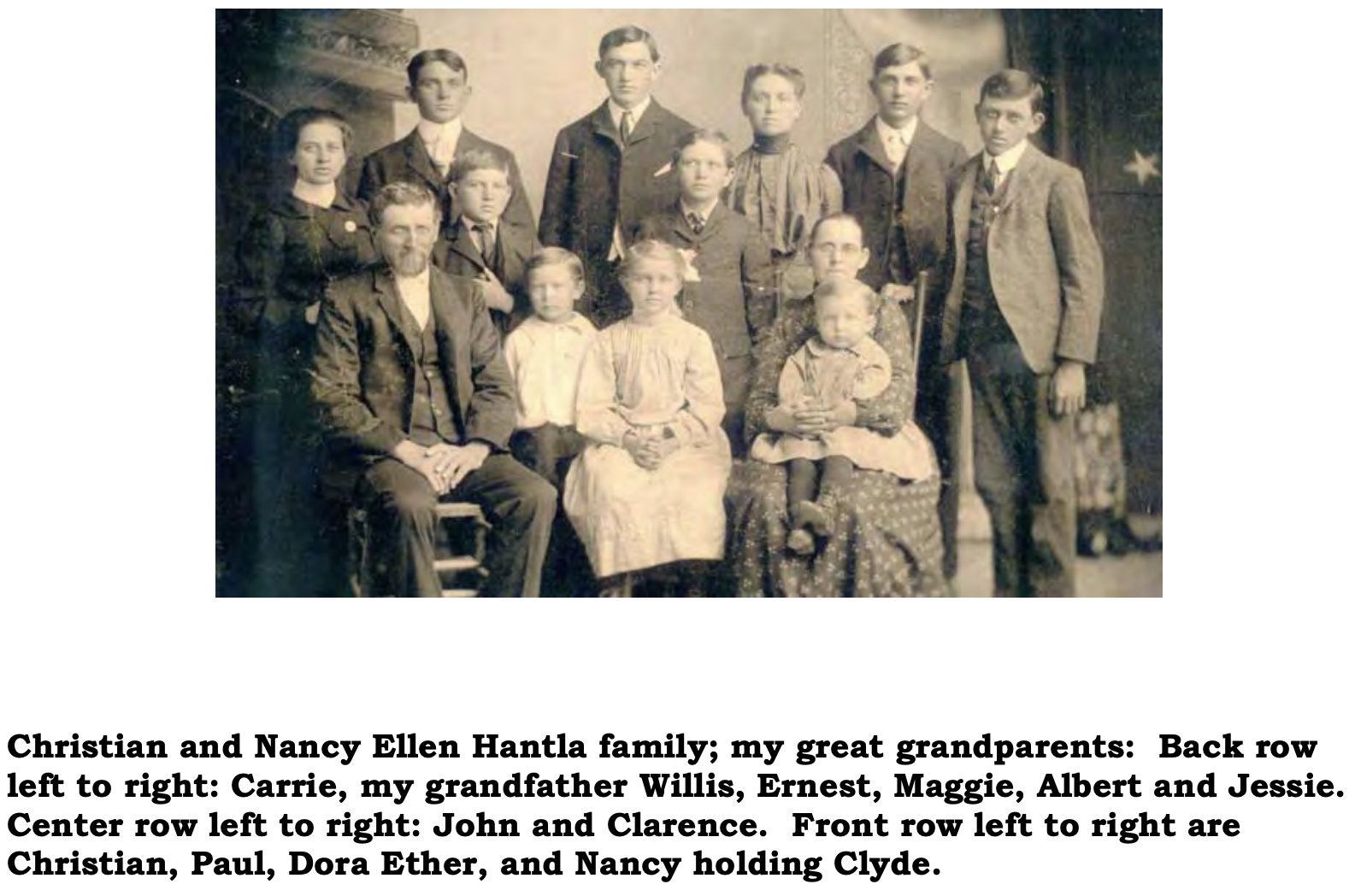
Just south and a little bit west of the farm a Negro family had their farm. The parents had both been born into slavery and had been emancipated and moved to Kansas. Residents of St. John used to gather at the old Opera House in St. John to celebrate emancipation day.

One of the earliest memories of John Perry Hantla (son of Christian) was the ride in covered wagon to Medicine Lodge, Kansas to attend camp meetings where Ruth Brown could visit her friend Carrie Nation.
As the children grew older they moved to St. John for town schooling. The Hantla family moved into a frame house in the southwest part of St. John and Christian continued to work as a farm hand. During these years of dry land farming without the use of modern tools, mules established themselves as a useful and economic work animal. Durability of the mule was superior to the horse. The same technology is still used today by the Amish in Pennsylvania farm country. My Grandfather Willis used mules for farming until 1931 and my father Willis Leroy lost 9 of his front teeth from being kicked in the mouth by a mule when he was 10 years old.
Pearl Hantla (wife of Jesse Ray Hantla, son of Frederick Hantla) had remembered a story from her childhood that rumored that a school teacher believed to be Nancy Ellen Brown-Händle changed the spelling of the family name from Händle to Hantla prior to her marriage to Christian in 1880. Several other scenarios of the name change range from mistakes by the census takers over the years like Hindle and Hendley in 1860 and 1870 or that it was Americanized in a family meeting after 1870 to use either Hantla or Hantle. The Kansas families used the spelling of Hantla and the Illinois families used Hantle. The actual truth remains unknown.
On May 18, 1906 Nancy at the age of 48 died of a ruptured appendix. Christian along with the help of the Brown’s took up the care and education of the children. Note the obituary below has 1906 marked out 1905 inserted. The year was 1906 by all data and accounts we have found.
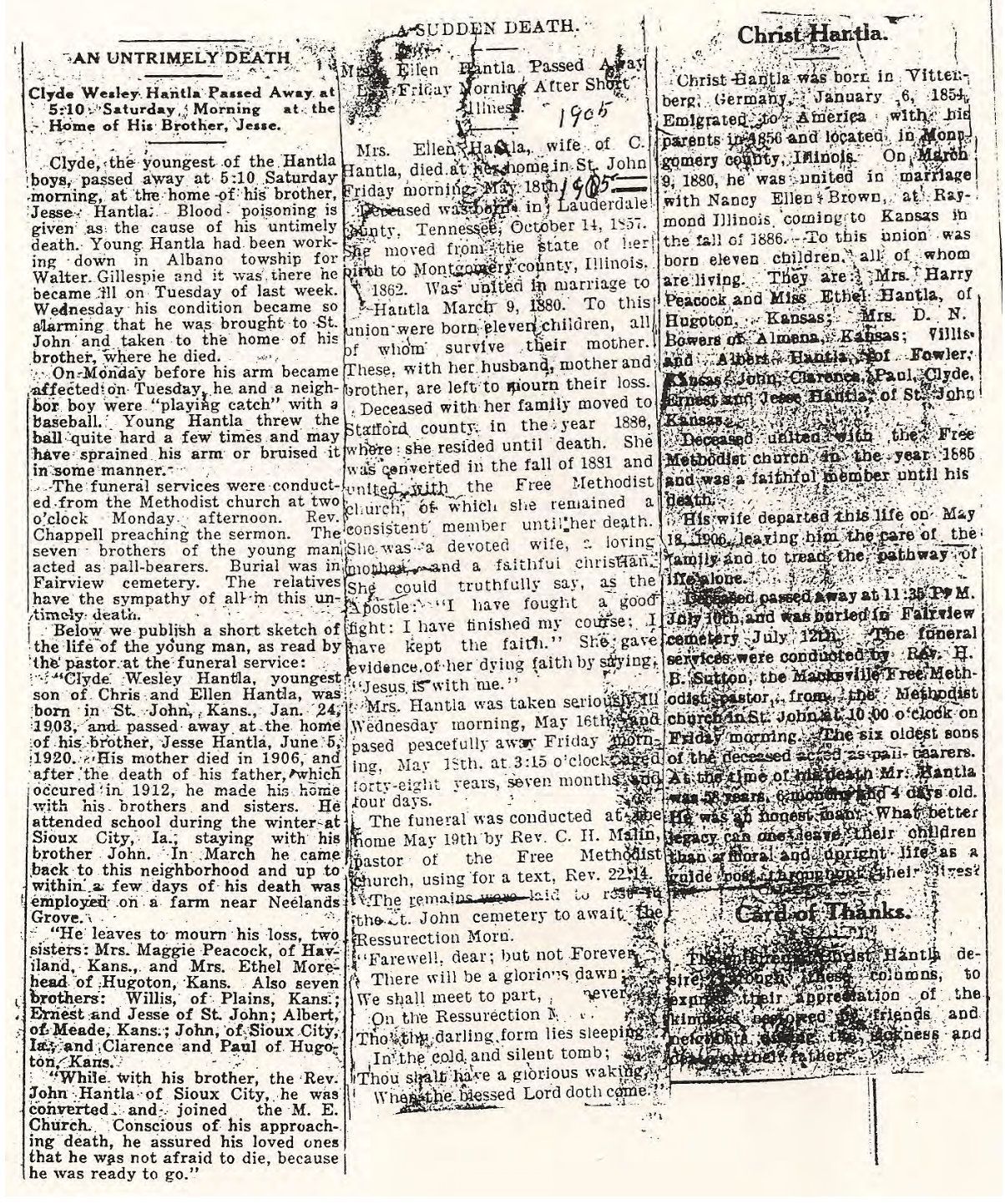
Christian and family lived for a short period of time in Santa Fe, Kansas.
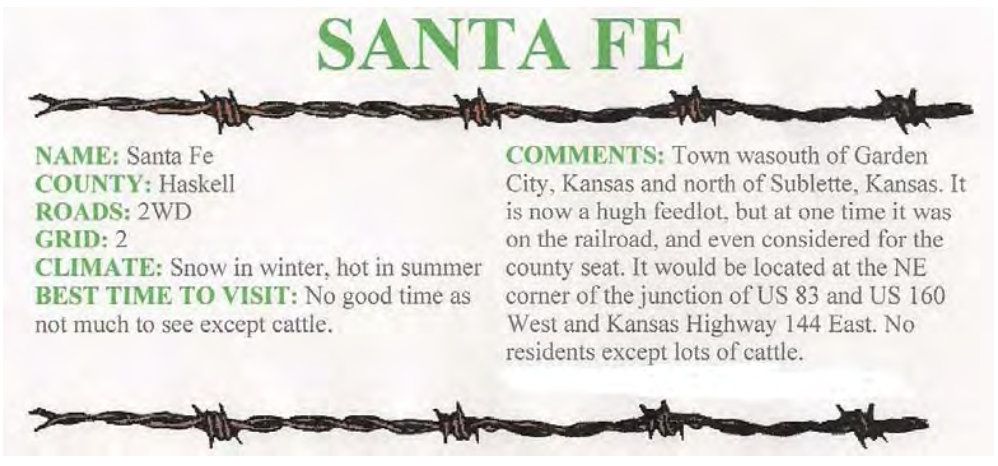
Today Santa Fe, Kansas is just another ghost town that was abandoned and dismantled in 1920. It appears to have been around from about 1885. Christian moved to Santa Fe for work as a farm hand.
Christian died on July 10, 1912. He is buried along side of Nancy in St. John Cemetery north of St. John on highway 281. John and Nancy are located in Section K, lot 39. In the same area of the cemetery are there son Clyde, brothers Paul and Jessie. Ernest Hantla is buried in Section J.
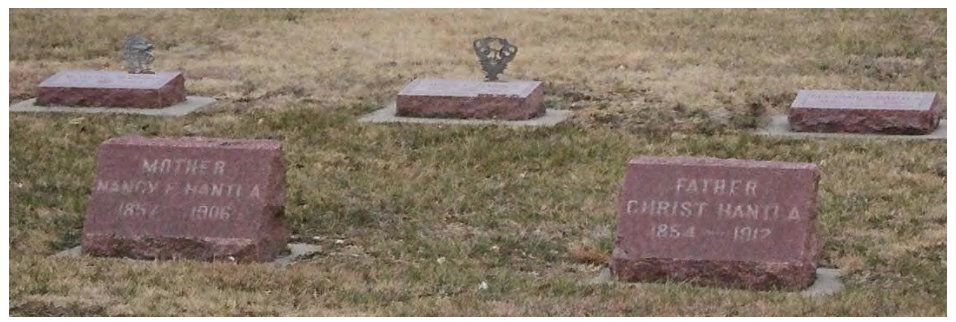
My grandfather was Willis Chris Hantla. He was born June 10, 1882 in Zion, Illinois and made the transition to St. John with his parents when he 5 or 6. He married Lena Leota Wilimine Davis on July 29, 1901 in St. John, Kansas. Lena was born December 8, 1881 in Chase, Kansas northeast of St. John. Lena’s father was from Ohio and her mother from Illinois. I have no account on how they met each other.
Willis along with his brother Albert first came to Meade County in 1909. Meade was a fast growing town on the railroad and lots of open range. They had made the decision to relocate and work leased land southeast of Meade. Willis felt the need for a tractor and thrashing rig was important because there were no steam tractors or thrashers in Meade County.
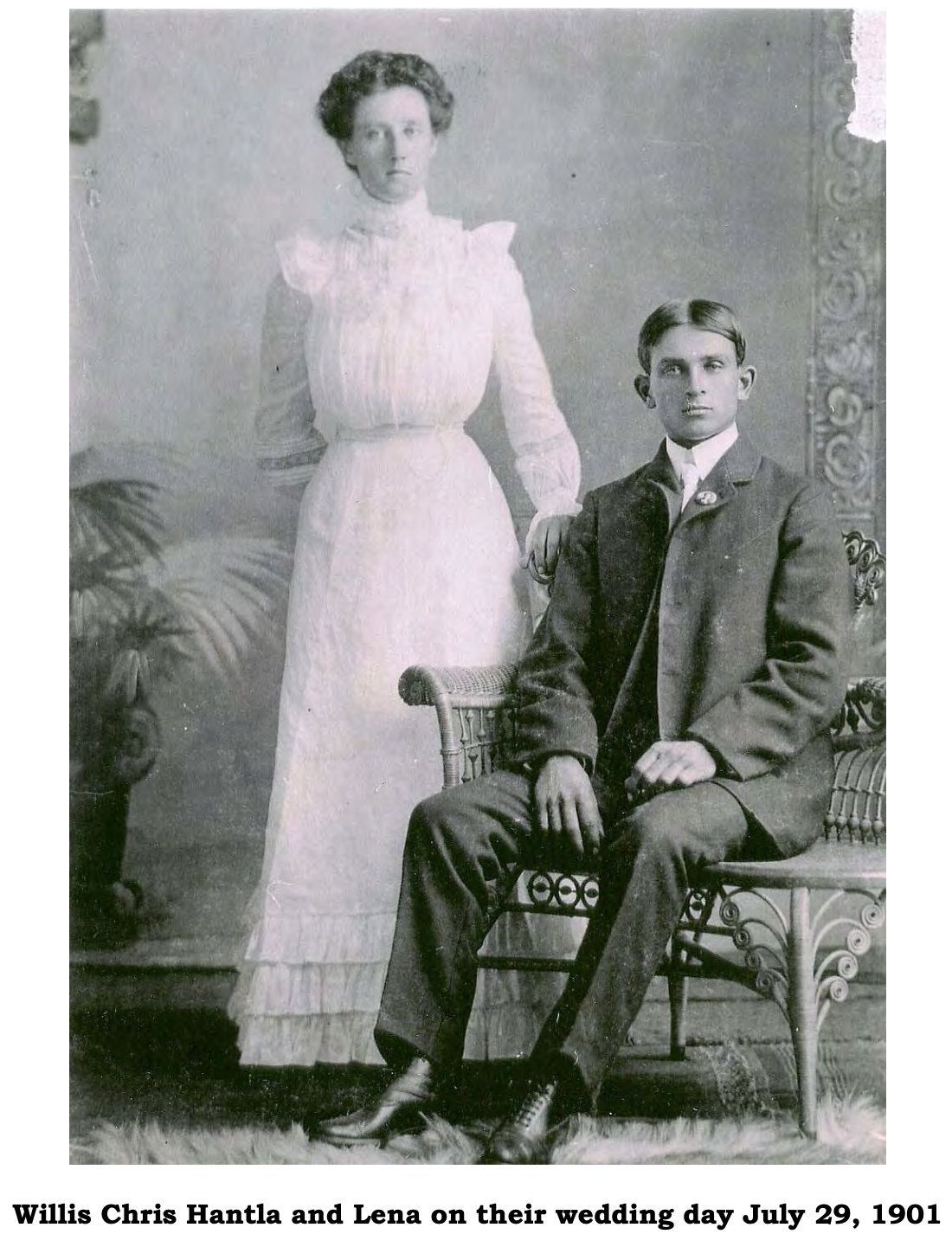
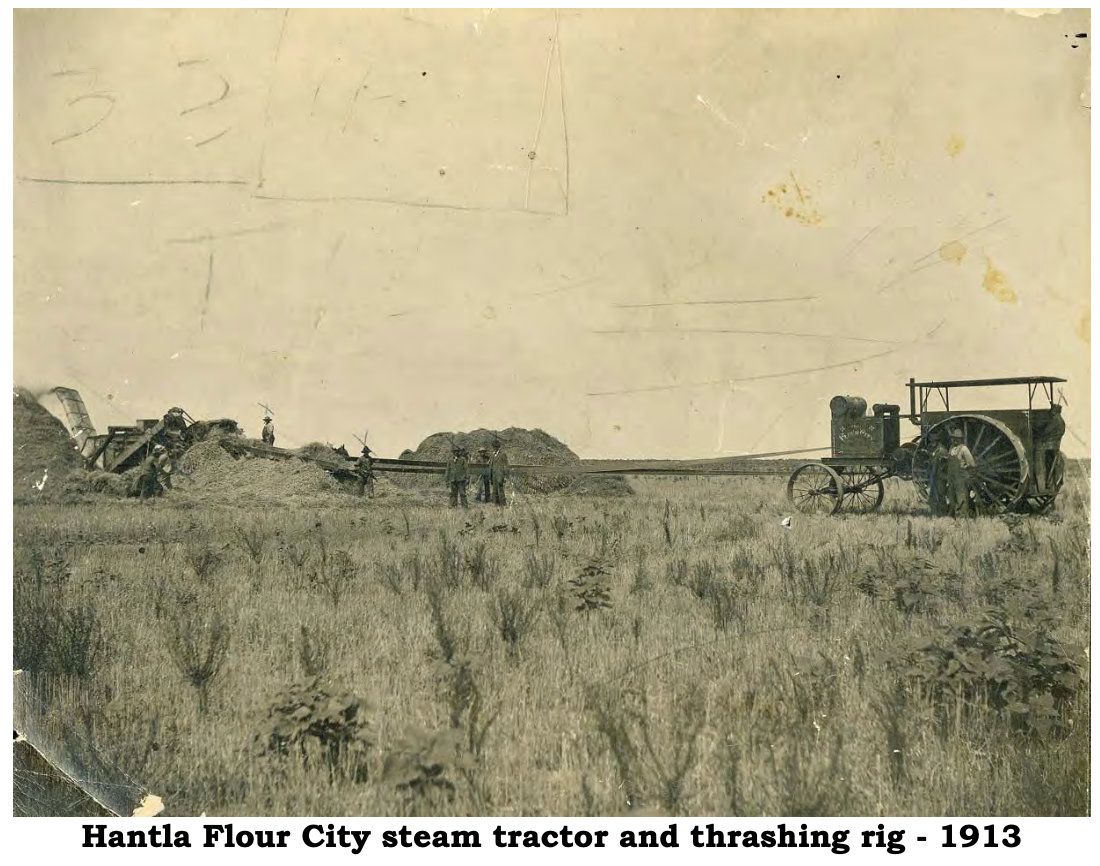
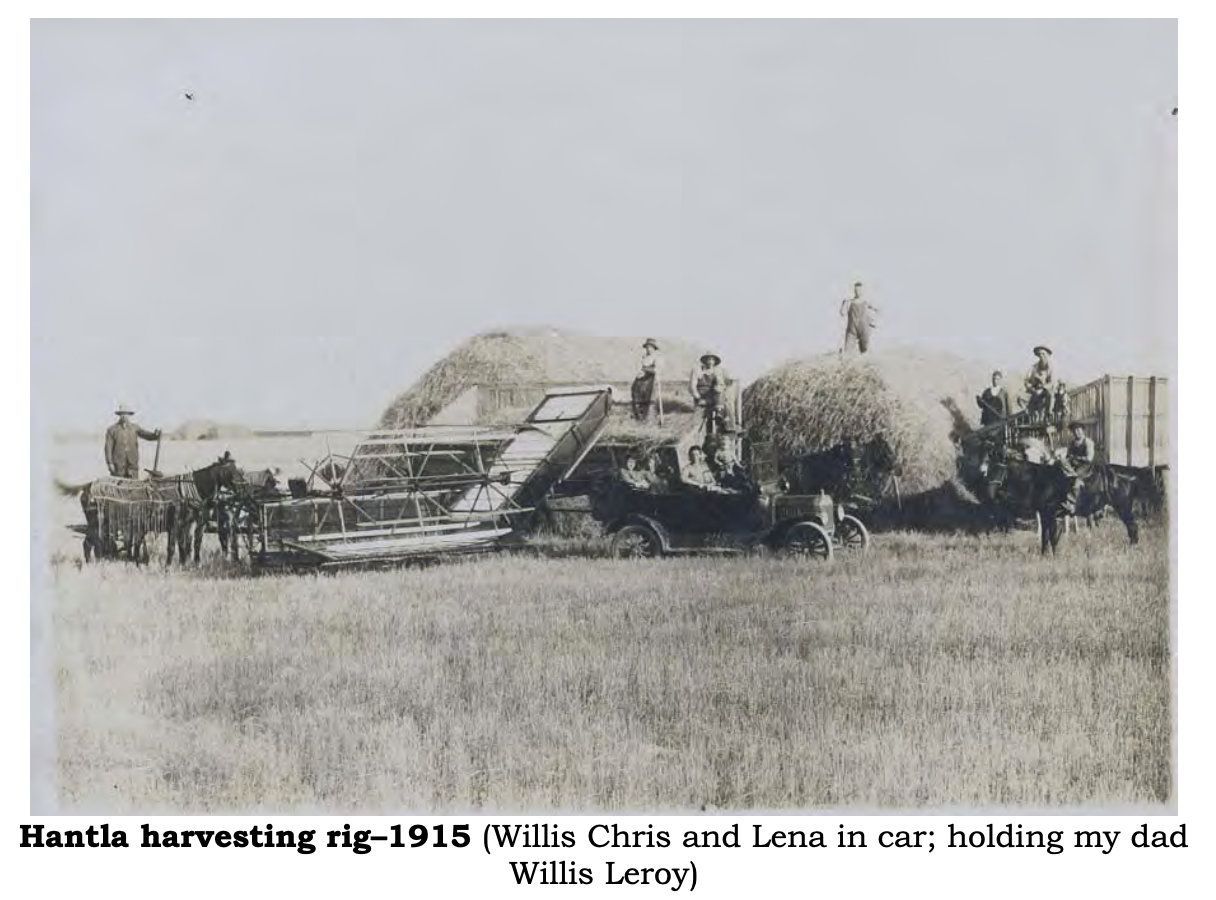
In 1910 Willis with brothers Albert, Paul and John and a caravan of three wagons made their way to Meade. Initially they lived in the covered wagon and built a one room shack. They returned to St. John for the winter and returned to Meade in the spring of 1911. They drilled a well and built a house and barn. Willis returned to St. John with the intention of returning to Meade with his steam tractor and thrashing rig. That summer of 1911 they were on their way. Willis drove the steam tractor and pulled the thrasher. Lena followed with a coal and water wagon behind 3-team of mules. Four miles per hour, they made it to Meade four days later. For the next several months Willis searched for a place of his own while working for other farmers in the area and establishing prospects for his thrashing machine. Willis returned to St. John in 1912. On May 9, 1912 he moved his family consisting of his wife Lena, his daughters Bessie, Wilma and Mabel to Meade. They moved to Meade driving a two cylinder Jackson car. They lived for two years southeast of Meade before relocating to a farm in Mertilda Township of Meade County (farm owned by Collingwood). The farm was 1 mile north, one half mile west and a quarter mile south of Missler. Willis started with 59 acres of dry land wheat and grew it to 1,100 acres.
Willis harvested and thrashed wheat all over Meade County for the next 18 years. Mules were used to plow the fields and the tractor was used only for thrashing wheat. The cost of coal made it impractical to use for plowing. So once again, through 2 generations mules were the work animal on the farm. Everyone prospered and lived well.
The kids attended school at both Sunnydale and Mertilda country schools. Mabel’s initials are carved in one of the window sills of Sunnydale School which now sits behind the lumber yard in Meade, Kansas with other historical items.
Albert quit farming in the early 1920’s and took up mining for volcanic ash. See web site oldmeadecounty.com for more detail on the Hantla mines, known in Meade as Silica.
World War I increased cultivation. Land was cleared of trees and grasses (see picture on next page). Farmers used every inch of land for planting and took no preventative measures like crop rotation and techniques to prevent erosion. 1925 to 1930 were crucial years with 5 straight years of drought. Then the dirty 30’s dust bowls hurt everyone from farmers to bankers.
In 1931 Willis gave up farming and moved to town (Meade) and took up the trade of plumber. Living in Meade is how I remember my grandparents and their home with a huge pantry with a never ending supply of oatmeal cookies and carrots.
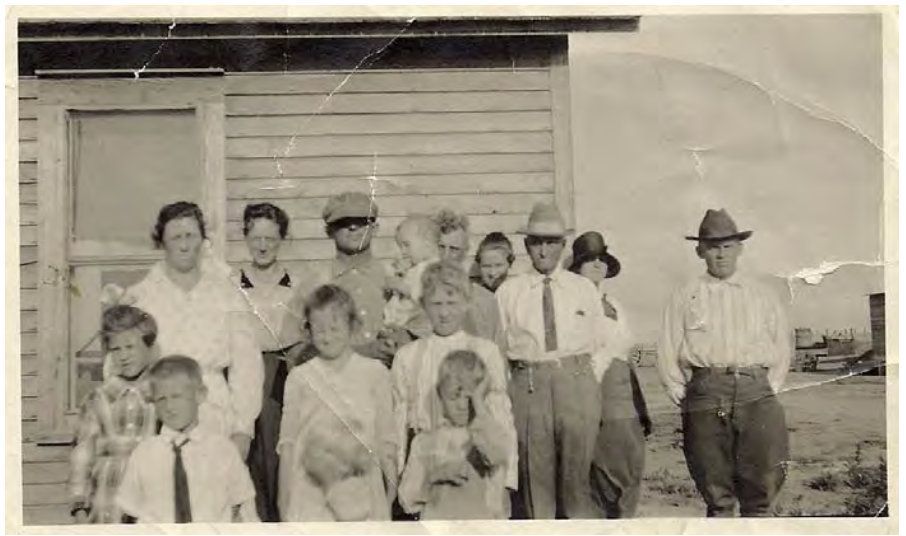
Willis C. Hantla and Rueben Davis families: front row boy in shirt and tie: my father Willis Leroy, the other girl and boy are part of the Davis family. Second row: girl at left is Wilma other girl and boy are Davis family. Third row left to right: Grandma Lena, Grandpa Willis C. holding Archie, the rest are part of the Davis family. Back row: you can only see her head is Mabel, and girl with hat is Bessie. The rest are part of the Rueben Davis family except man at far right is hired hand. Note the lack of trees.
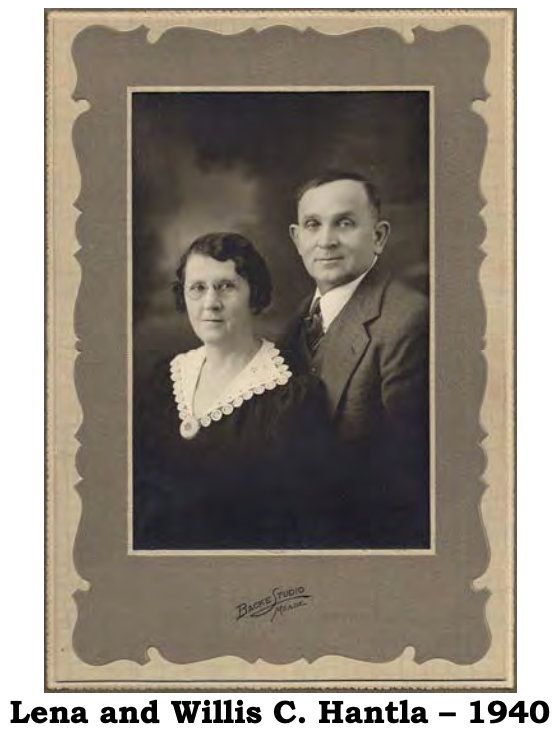
Grandpa Willis died October 16, 1959. Grandma Lena lived on her own for the next 3 years and then lived out her last year of life at the Lone Tree Lodge. My best memory of Grandma was Christmas 1962. She didn’t have much to give but simple gifts are always the best. She had an apple for my sister Gayla, an orange for Cindy and a little yellow pocket knife for me. I still have the knife. Grandma pasted away on February 12, 1963. They are both buried in Graceland Cemetery east of Meade, Kansas.
My father was Willis Leroy Hantla: aka Leroy, Hank, Willis Junior, Bill Jr., and W.L. He was born on the farm northwest of Meade on May 9, 1914. He often told me of the hard back breaking work on the farm when he was young. He attended school until he was a sophomore in high school and worked for his father until he stopped farming in 1931. For the next 12 years Leroy worked for Hartshorn Implement repairing farm implements and heavy equipment.
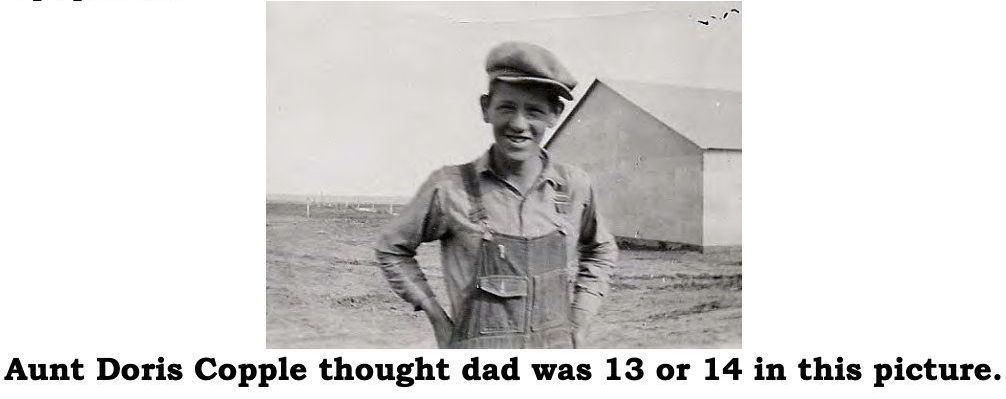
In 1934 Leroy married Mildred M. Lockhart and they had two girls, Beverly Jane and Marilyn Sue. The marriage ended in divorce 4 years later but Sue and Beverly have always been a loving part of our family.
In 1941 a beautiful and young Ruth Adelle Peterson moved from Council Grove, Kansas to Meade where she met the ruggedly handsome Willis Leroy. Ruth worked as a beautician and received her beauty operator certification in 1942. A few lunches and dinners together was all they had of their courtship before Leroy entered the service in the winter of 1942.
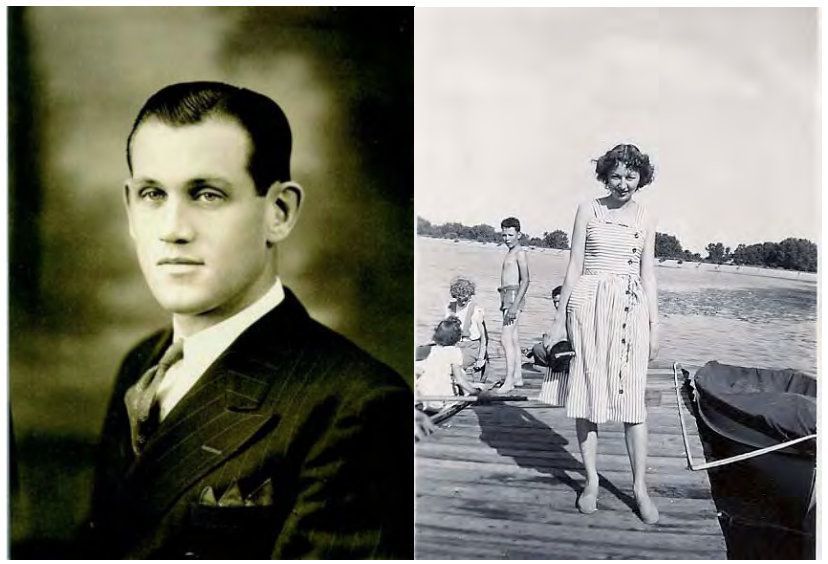
A couple of months after dad left for the Navy, mom moved back to Council Grove and worked as a beautician for a few months before applying for a job at Boeing in Wichita. They hired her on the spot and Ruth moved to Wichita in 1943 with two friends from Council Grove. Ruth worked in the Treasury Office of Boeing doing payroll. Her only contact with Leroy was through letters and post cards that they wrote each other over the next two years.
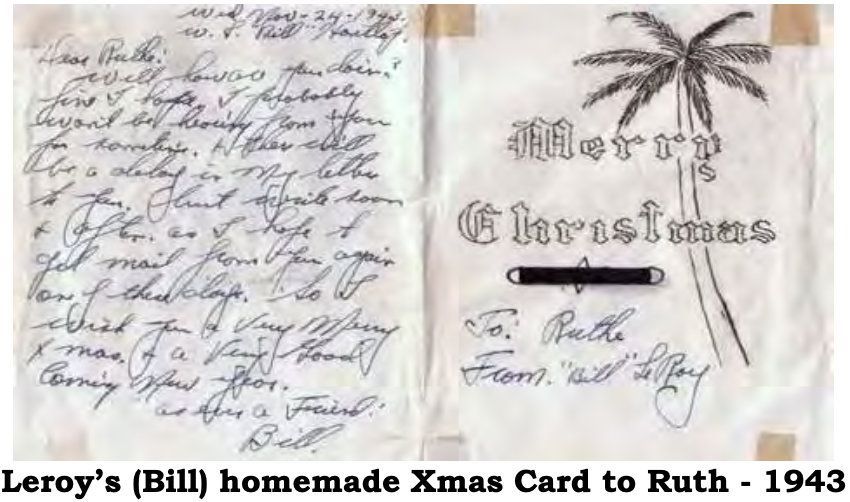
Dad was a Navy Seabee during World War Two and was stationed on Bougainville, Solomon Islands, territory of New Guinea.
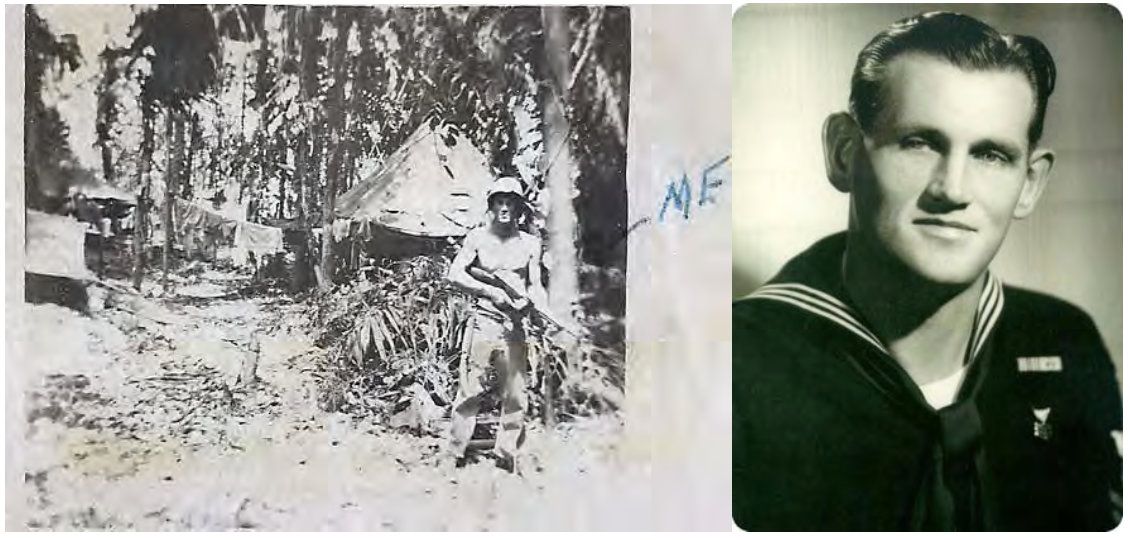
The CB insignia on dad’s left forearm sleeve of his wedding picture on page 23 stands for Construction Battalion. In 1942 allied forces in Operation Cartwheel and then again in 1943 in Operation Cherry Blossom took Japanese air bases and air strips at Torokina. Once in possession dads job was keep the air strips in working order for the incoming and outgoing planes. One of those incoming planes was piloted by his brother Archie Hantla. It was the one and only time they saw each other during the war.
In 1943 the Japanese temporarily took possession of Torokina before the allied armies beat them back. Dad’s friend Kelly was killed defending the airstrips. A picture of the location of Kelly’s grave is shown above. The sign over the entry way says “Army Cemetery No. 1. I do not have Kelly’s last name. Dad told me once, but I was too young and now too old to remember.
Dad returned from overseas and asked for Ruth’s hand in marriage. She said yes and they were married in Wichita on October 2, 1944.
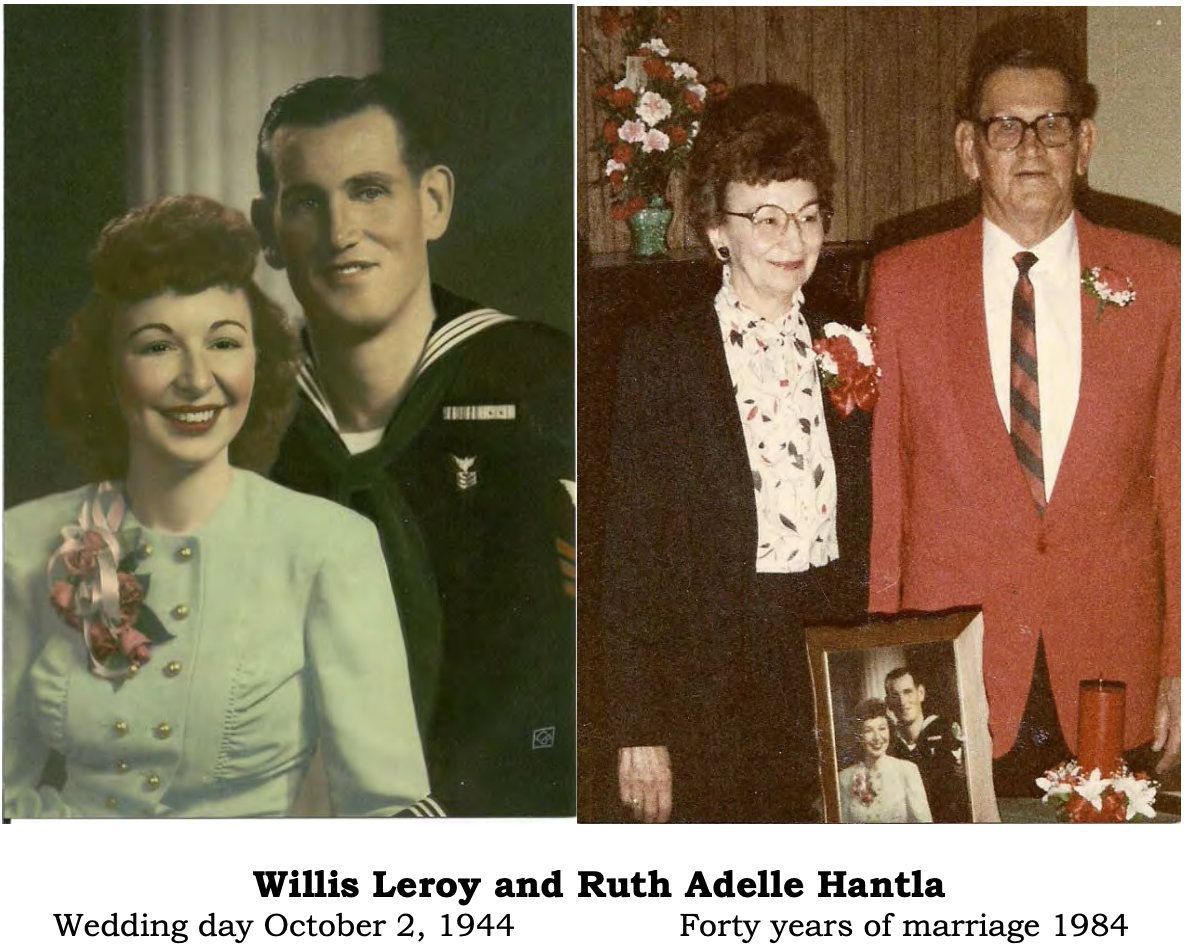
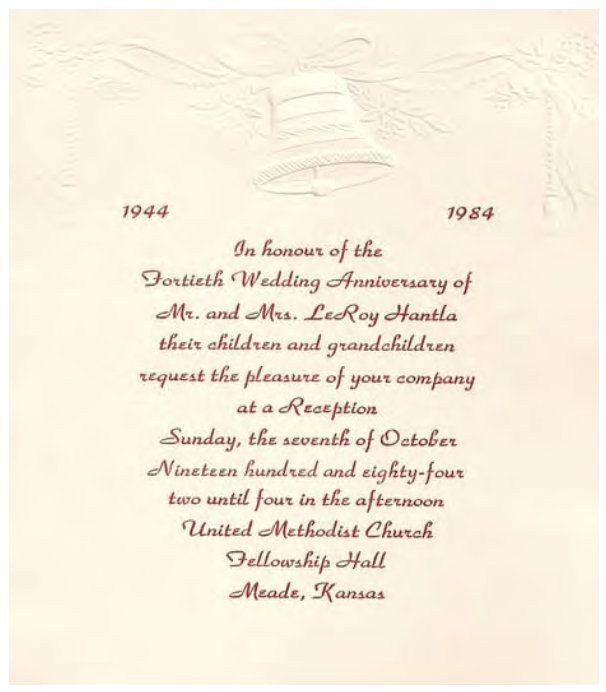
Leroy was still obligated to the Navy and having contracted malaria while overseas dad started to have a relapse and was sent to his base in Oakland, California in 1944. Mom stayed in Wichita and worked for a short time and then went to Oakland to be with dad. He was transferred to a new base in Bangor, Maine because of the cool weather as part of his treatment for malaria.
Mom and dad lived in Maine for nearly a year and dad was released from the navy, malaria free. They moved to Kansas and settled in Meade. Dad went back to work repairing heavy equipment until 1947 when he was hired by Michigan Wisconsin Pipeline Company.
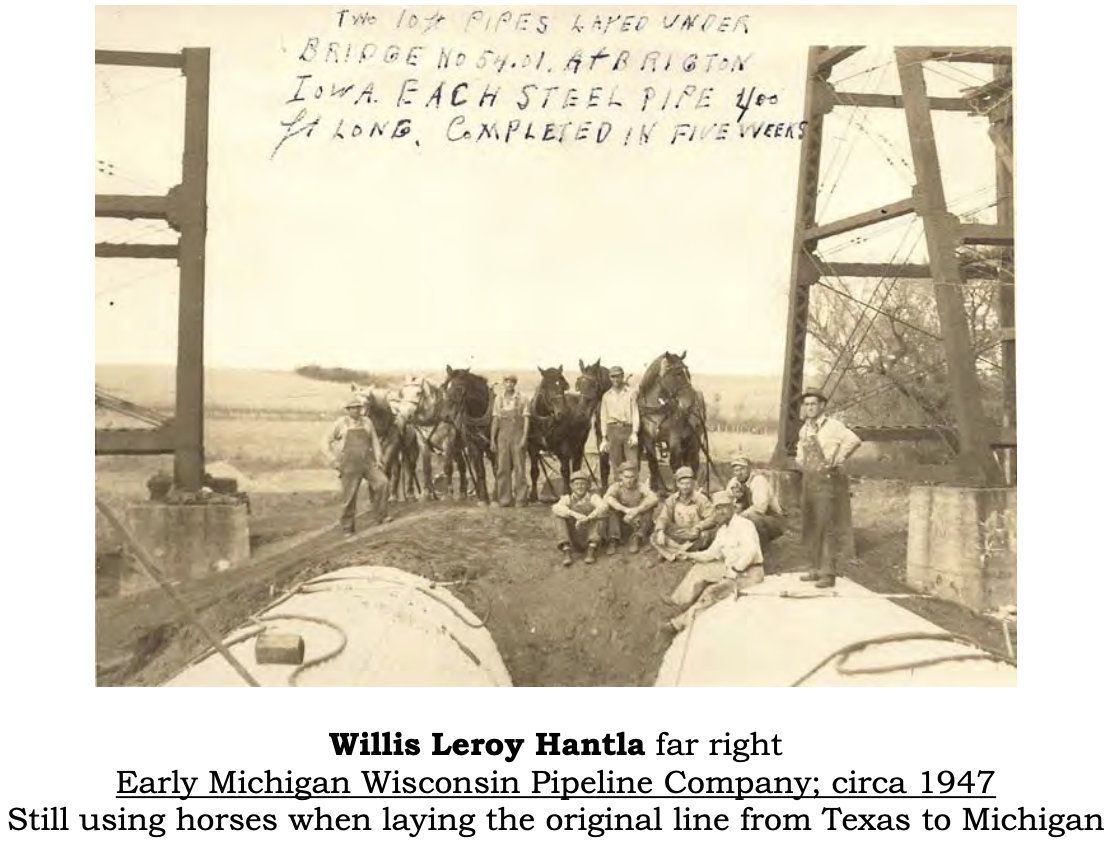
Leroy did well with Michigan Wisconsin Pipeline and was eventually made District Superintendant. Leroy oversaw operations in Oklahoma and Kansas.
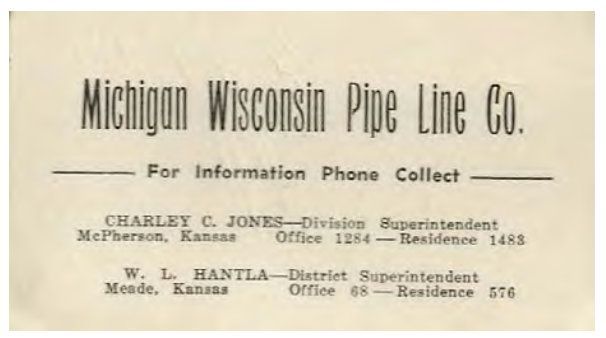

Leroy Hantla spent 26 years with Michigan Wisconsin Pipeline Company until he was medically retired and diagnosed with Lou Gehrig Disease in July of 1973. He was told he had 6 months to live in 1973, but through his great will not to give up lived another 17 years. The diagnosis was later changed to Guillain Barre Syndrome.
Leroy and Ruth were both great parents and had 7 children: Gayla, Brian, Cindy, Cassy, Marsha, Janice and Troy. All attended Meade schools and graduated from Meade High School. Leroy was married to Ruth for 46 years before he died July 19, 1990.
Leroy Hantla was my baseball coach, Boy Scout leader and my childhood hero. He had a heart of gold and a demeanor to match. We all miss him very much.
Händle - 1725 to Present Day Family Tree
The original spelling of the family name was Händle. The umlaut (ä) was dropped in recent research transcript and æ is used. The spelling changes to Hændle. The name changed to Hantla occurred sometime between 1880 and 1900. Christian and his wife, Nancy Ellen were the first to use the current spelling of Hantla. Those who stayed in Illinois and did not migrate to Kansas adopted the spelling of Hantle.
This family history begins in 1725 with Johannes born in Höpfigheim, Germany. Allo
prior accounts and information are very limited. Relatives of Johannes were in Höpfigheim back to 1665. It was not unusual for more that one brother to have the same name as the father.
The first complete and readable Lutheran record of Händle's in Germany begins in 1760 with the only child of Johannes and Elisabeth; Johannes. Johannes the son was also born in Höpfigheim and his first wife Anna was born Mundelsheim. Eleven children were born during their marriage. It is not known if any lived to maturity. Anna died in 1805 at the age of 45. Johannes was a widower for seven years before he married the second time to Catharina Stængle in Benningen, Germany. Catharina's father was a vine grower.
Johannes was a farmer. It is believed he grew a mix of grapes, wheat and barley.
